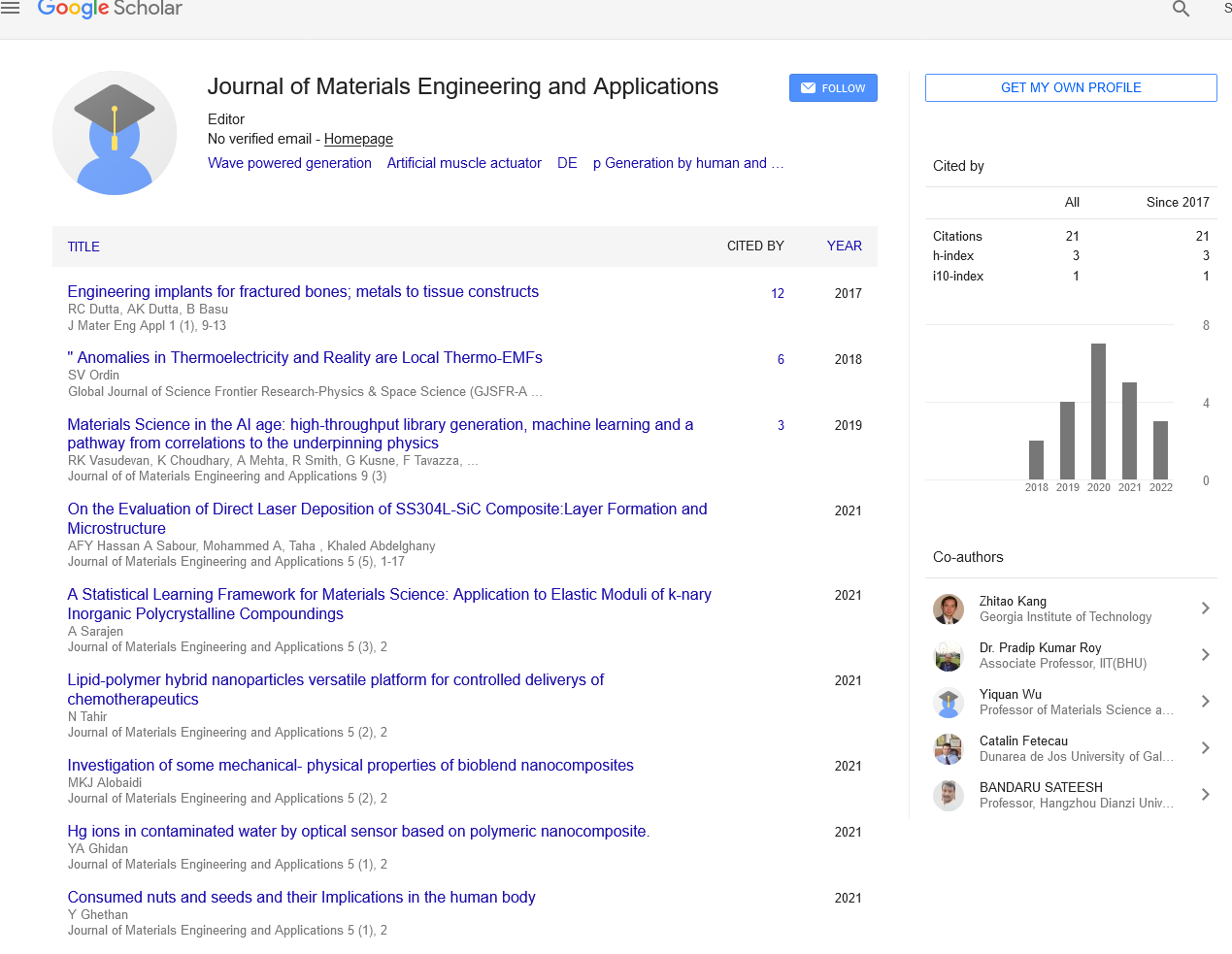Additive manufacturing technologies applied in materials engineering
Received: 11-Sep-2017 Accepted Date: Sep 20, 2017; Published: 28-Sep-2017
Citation: Zeming H. Additive manufacturing technologies applied in materials engineering. J Mater Eng Appl. 2017;1(1):1.
This open-access article is distributed under the terms of the Creative Commons Attribution Non-Commercial License (CC BY-NC) (http://creativecommons.org/licenses/by-nc/4.0/), which permits reuse, distribution and reproduction of the article, provided that the original work is properly cited and the reuse is restricted to noncommercial purposes. For commercial reuse, contact reprints@pulsus.com
The technology of additive manufacturing (AM), also referred to 3D printing, rapid prototyping or solid freeform fabrication, has been growing rapidly recently. The ASTM technical committee defined AM technologies as the “processes of joining materials to make objects from threedimensional model data, usually layer upon layer, as opposed to subtractive manufacturing methodologies” [1]. With increasing interests, AM is continuously being redefined, reimagined and customized to a wide application spectrum such as automotive, aerospace, medicine, biological systems and food supply chains [2]. AM processes cover a series of technologies, and they were classified into seven categories [1]. According to the state of starting materials used, AM processes could be divided into four broad areas: liquid, filament/paste, powder and solid sheet [3]. Among them, there are popular techniques, such as stereolithography (SLA), fused deposition modeling (FDM), selective laser sintering (SLS), selective laser melting (SLM), electron beam melting (EBM), inkjet 3D printing (3DP) and laminated object manufacturing (LOM), which are employed widely in R&D and product fabrication for various applications. Compared to conventional manufacturing processes, AM processes have several perceived advantages. The most predominant one comes from its free of complexity. The more complex of the component, the easier it can be made using AM. Another point is that AM technology can provide customised product to meet a personal demand, while conventional technology can only produce the one with predetermined design and standard. Other advantages of AM also include less materials waste, reduction of carbon foot print, little lead time, moldless process and no assembly required [4,5]. Materials have three categories of metals, ceramics, polymers and their composites. Materials engineering focuses on the synthesis, processing and assembly of materials into engineering products. It takes advantages on the fundamental knowledge gained from materials science and employs the involved techniques for producing the products for various applications. Technological innovations have definitely contributed to product performance and productivity improvement in materials engineering. At the present time, the extensive application of advanced materials depends on the technological availability to fabricate complex components with the required geometry. In addition, it is difficult to implement new activity in test stage for smallscale manufacturing, as the cost for mold design and fabrication is expensive. Due to their perceived advantages, the emerging AM technologies provide novel and feasible solutions to the issues raised in materials engineering.Nowadays, AM technologies have been developed highly and applied intensively in materials engineering. The patents and the publications on materials preparation using AM have been reported frequently, and it make AM become a hot topic in materials R&D and product commercialisation. SLA, FDM, SLS, SLM, EBM, inkjet 3DP and LOM have been employed widely to develop materials for various applications. Metal-, ceramic- and polymer-based components with more near-net-shaped configurations and comparable or even better performance than that made from conventional processes have been achieved using AM processes [6-8]. As emerging technology, AM has challenges as well as advantages. As summarized by Ford and Despeisse [9], there are a series of challenges need to overcome before wider adoption and realisation of the benefits of AM, due to the immaturity of AM technologies for direct manufacturing. However, the rapid pace of change in the industry and technology means that it is highly likely that new development of AM with further benefits will soon be created. With realistic anticipation, the application of AM technologies in materials engineering will brighten in the future and be of interesting perspectives.
REFERENCES
- ASTM, F2792-10 Standard terminology for additive manufacturing technologies.
- Gao W, Zhang Y, Ramanujan D, et al. The status challenges and future of additive manufacturing in engineering. Computer-Aided Design. 2015;69:65-89.
- Guo N, Leu MC. Additive manufacturing: technology, applications and research needs. Frontiers of Mechanical Engineering. 2013;8:215-43.
- Huang SH, Liu P, Mokasdar A, et al. Additive manufacturing and its societal impact: a literature review. The International Journal of Advanced Manufacturing Technology. 2013;67:1191-203.
- Mahamood RM, Akinlab ET. Lasers in Engineering. 2014;27:167-78.
- Tapia G, Elwany A. A Review on Process Monitoring and Control in Metal-Based Additive Manufacturing. Journal of Manufacturing Science and Engineering. 2014;136:060801-10.
- Travitzky N, Bonet A. Additive manufacturing of ceramic-based materials. Advanced Engineering Materials. 2014;16:729-54.
- Wendel B, Rietzel D, Kuehnlein F, et al. Additive processing of polymers. Macromolecular Materials and Engineering. 2008;293:799-809.
- Ford S, Despeisse M. Additive manufacturing and sustainability: an exploratory study of the advantages and challenges. Journal of Cleaner Production. 2016;137:1573-87.





